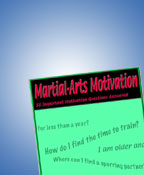Did you know that in a lot of martial arts schools, students tend to imitate their teacher?
Imitating the teacher can be good for the students. It can also be detrimental to their learning process.
If you are the teacher, and you have a devastatingly fast punch, then your students use your punch as their model. The closer they come to copying the speed and precision of your punch, the better they will become.
This type of imitation is good. And it's a necessary part of learning.
On the other hand, if your students avoid certain techniques, because you do, then you could be hindering their progress. A lot of good techniques have been discarded, because of teacher or student bias.
Let me give you an example:
Long ago, my teacher, Steve Golden, taught us how to take a knife thrust to the midsection. The attacker, your partner, would thrust, and you responded with a pat on his wrist or arm that guided the knife hand past your body, while you kicked at your attacker.
We practiced. We got the timing down. We picked our targets for our kick.
We developed follow-up moves.
Yet, over the years, I dropped the exercise from my repertoire. I decided not to teach it to my students, because it felt like a dangerous move:
* What if the attacker pulled the blade back, slicing your wrist?
* What if you tried to guide the hand, and your timing was off, so you put your hand right on the blade?
* What if the attacker hadn't committed to the thrust and was able to stab at your kick with the knife?
Nope, this was not the move for me ... or my students.
During one afternoon of our 3-day outing, we started practicing against knife attacks. And wouldn't you know it, we practiced the move that I had discarded years before.
I was a little less than enthusiastic about this exercise. So, I decided just to watch the other teachers and their students practice.
From the sidelines, I made several observations:
1) The other teachers weren't enthusiastic about this technique either.
2) Some of the teachers had great kicks ... and their students had great kicks.
3) Other teachers were great at 'passing' the knife ... and their students seemed able to guide the knife to the side as well.
What was really interesting was that the kickers couldn't pass, and the passers couldn't kick. Hmmm.
I think Steve Golden noticed this too.
So, he broke the exercise into two parts -- the passing and the kicking. He had us practice the kicking first. We practiced demolishing three targets -- the knee, the groin, and the stomach.
And we practiced that kick from a 'stepping-in' distance.
Then we worked on the proper timing to get an attacker to really commit to the thrust with the knife. And we passed it.
Then we put the two moves back together.
After eliminating the teachers' bias (weakness?), we had a very strong technique. And all of the teachers' students now had a well-rounded technique.
We relished getting our attackers to thrust with the knives as we blasted through their midsections.
Neither should you emphasize the entry moves, only to follow with an 'anemic' strike or kick.

Actual questions from my readers all on motivation -- finding practice partners, the time to train, the will to train, the motivation to keep going.
One tip from these pages could make all the difference in your martial-arts training and improvement. Read more about 58 Martial-Arts Motivation Questions ...FREE
Martial Arts
Weekly ezine
Mastery